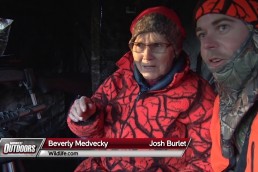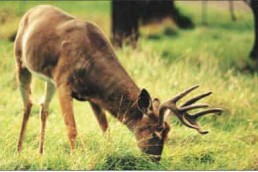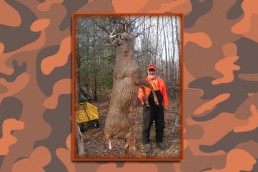Understanding Deer Rubs a Key to Success
SHARE THIS POST
Whitetail hunters have always scouted for and used sign left behind by whitetails to their advantage to be able kill bigger deer. Scrapes, rubs, trails and even shed antlers are all good indicators of which deer are in the area and what they are doing. If I had to make a choice between rubs or scrapes being the best whitetail sign, rubs would win hands-down every time.
Rubs often tell more about the size of animals in the area and their travel patterns than any other type of sign. Often, rubs reveal information about one individual buck, whereas scrapes are usually about all the deer in the area that are likely to visit a scrape.
I love finding a stout cedar tree several inches in diameter ripped to pieces by a mature buck. At the very least, it tells me a big buck is in the area, but it can provide so much more information. A hunter can look at a rub and know when it was made, about how old the buck was that made it and which way he was moving. I do not know of any other type of sign that can do all that.
Early season rubs
A buck makes two types of rubs. The first type is an early season rub. One reason a buck makes an early season rub is to build neck and shoulder muscles. Bucks have to be in good shape when the rut begins and fights occur. It is also a good way for bucks to let go of built-up testosterone. Rubs are also used to mark boundaries, both by the sight of a freshly rubbed tree and the scent left behind from forehead glands.
Rubs start to show up in late September and early October. Common trees that bucks choose are healthy and 2 to 4 inches in diameter. Lines of rubs are often made as a buck travels from his feeding area to his bedding grounds in the morning and vice versa in the afternoon. Hunting one of these rub lines might be the best chance to harvest a mature buck prior to the beginning of the rut.
When you are scouting or even hunting and come across a rub, a cluster of rubs or a rub line, keep track of their location in a notebook or on a topo map. Backtrack any nearby trail to possible bedding grounds or early season feeding grounds like corn, soybeans, alfalfa, hard mast like acorns or soft mast such as persimmons and apples.
When you locate rubs near food sources, search for a good stand location. Pinch points, funnels, benches and saddles are all good choices.
Do not count on rubs early in the season to put you on top of a trophy whitetail. Unless the rubbed tree is huge, it is difficult to know exactly the size of the deer that made the rub. This is the time of year that bucks of all sizes are rubbing trees to scrape off their velvet.
If the only reason a buck rubbed a single tree was to remove velvet, he probably will not be back to that tree. If you can find a rub line on a travel corridor between feeding areas and bedding grounds, it might be worth hunting.
Put out a trail camera and see what is making the rubs. Otherwise, scout food locations from afar prior to the season to find big bucks and set up stands accordingly.
Rubs during the rut
The second type of rubs are the ones made during the rut. Around the end of October, bucks’ testosterone levels rise up and does come into estrus. To find a buck now, hunters need to hunt where the does are. Bucks will be on the prowl for “hot” does and continue to make rubs as they do so.
Bucks will create breeding rubs to show other bucks their dominance. Also, this is a good opportunity for bucks to leave their scent behind to let other bucks know they are in the area.
Not often, but possible, is for a several bucks to work the same rub. When several bucks work the same tree, they are communicating through the scent they leave behind from their glands. These rubs are often called sign-post rubs and are used so much from one season to the next they take on an hour-glass shape.
These types of rubs are not always easy to understand and can be very misleading. Hunters think because of all the damage that has been done to a single tree that a monster buck is in the area. There might be a large buck involved, but it could just be a lot of smaller bucks. The best way to tell if a sign-post rub is worth hunting is by using a trail camera. Get some photos of the deer visiting the rub. Maybe one or more bucks is a “shooter.”
Using rubs to kill mature bucks
When you get into a buck’s bedding area, you will likely find several rubs. The problem is they are difficult to hunt because of their close proximity to the bedding area. Preferably only hunt this area in the morning, but be prepared to stay all day if you don’t kill a deer early on.
This will prevent you from spooking deer once they return to bed. It is possible to get a shot opportunity at midday on a buck that has got up to stretch his legs, get a drink or use the bathroom.
Are you enjoying this post?
You can be among the first to get the latest info on where to go, what to use and how to use it!
Do not chance going into the area in the afternoon for an evening hunt. You will not get away with it.
In the evening, stay downwind of the bedding areas. Hang a stand in a funnel along a rub line leading from the bedding area to the evening food source.
Rub line
I consider a rub line to be at least six trees that have been rubbed within 50 yards. All of these trees will lead to one general are in a definite travel path. This is enough proof that a buck has been in the area more than once. Keep tabs of any new rubs and keep notes on a topo map or in a notebook.
A few years ago, we planted small saplings of cottonwood, pecan and walnut trees on our family farm. Last year, I found twenty-one rubs on the edge of the young forest that had been shredded. All of these trees were within 100 yards from the first one. Also, all the trees were at least 3 inches in diameter.
This information proved to me that a least one mature buck was visiting the area daily. The other possibility is that I had stumbled upon a whitetail breeding area. I quickly put up a stand. Four days later, a good friend took a nice 143-inch 8-pointer.
You can tell a buck’s direction of travel by a rub line. Most of the rubs will be facing the same direction. Bucks will normally be coming from the direction of the rubbed side of the trees. But, there might be a time when a buck catches the hunter off-guard and comes in from the other direction. Individual rubs are neat to see, but a rub line shows the route a buck takes on a daily basis.
How old is the buck?
Big, old bucks will shred small trees and 1 ½-year-old bucks will attack big trees. However, this is not normal. Usually a hunter can estimate a buck’s age by how big the tree is that has been rubbed.
One-to-2-inch diameter trees are visited by 1 ½-year-old deer.
Two- to 4-inch thick trees attract 2 ½- to 4 ½-year-old bucks.
Anything bigger than 4 inches in diameter is rubbed by deer 5 ½ years old, or older.
Small saplings and thick-stemmed brush can be rubbed on by a buck of any size.
Of course, the best way to know what caliber of bucks are in the area is by utilizing trail cameras.
Normally, when you find a big rub, a big deer is nearby. Find a line of big rubs and hang a stand on the buck’s travel corridor and you have a good chance at success. Your odds for success increase if you can set up in a funnel.
Don’t think just because you find a rub line that you will kill a deer. Rub lines provide a lot of information, but most times a little more scouting is needed to get the stand in the right spot for a shot. Once you have a better understanding of rubs, you will be one step closer to getting that next wall hanger.
Become a MidWest Outdoors Insider here!
MWO
SHARE THIS POST
Did you enjoy this post?
You can be among the first to get the latest info on where to go, what to use and how to use it!
Jason Houser
Jason Houser is an avid outdoorsman from Central Illinois. Houser has been a full-time freelance writer since 2008. He is also the host of Jason Houser Outdoors, airing on the Hunt Channel. He can be found on Facebook at Jason Houser Outdoors or on the web at jasonhouseroutdoors.com.



